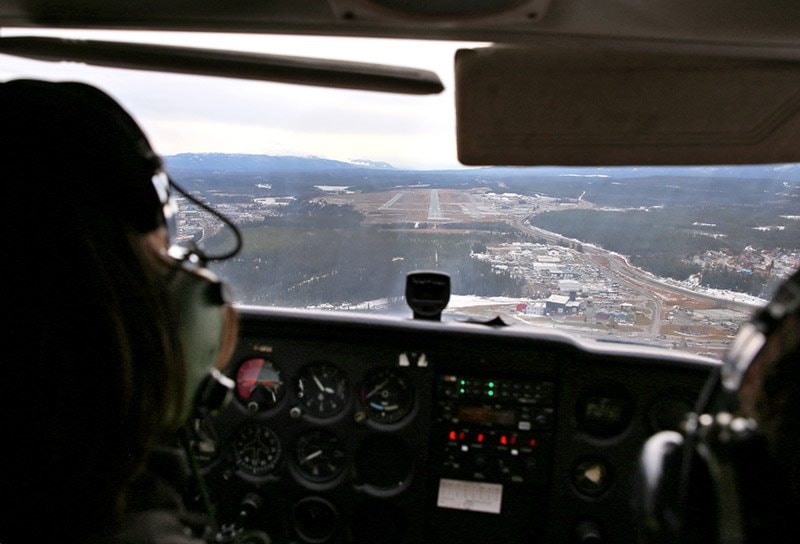When the 2008 financial crisis hit, Steve Kinoshita was working in Tokyo.
He was working in finance, and the cascading economic calamities roiling world markets made him think it was time for a change. Maybe it was time to accomplish one of his oldest dreams: becoming a pilot.
All he needed was the right opportunity. That happened last year when his wife saw an article about Alkan Air’s flight school.
“Hey you need to apply now,” she texted him.
Today he is one of Alkan Air’s first students.
Flanked by his wife and daughter, Kinoshita was at the company’s official opening of its new flight training unit on Wednesday.
For the occasion the company brought new students, flight instructors, and Yukon College officials to celebrate.
The new building has several classrooms and a flight simulator for new students, for which instructors can choose a variety of weather situations and airplanes.
Alkan Air started offering flight training for private and commercial licenses last year, partnering with Yukon College to offer a two-year diploma program.
Flying courses count for credit, and the college teaches business classes.
“My original aspiration was to become a bush pilot,” Kinoshita said.
He started the flight training in September, while taking the diploma courses. He’s already completed his first solo flight around Whitehorse.
It is the part of the training that every pilot remembers, said Alkan Air president Wendy Tayler.
Instructors typically will gauge whether their students are ready for their first solo flight, but they won’t let them know in advance.
On the day of Kinoshita’s solo flight, chief instructor Jenna Collee first went with him do a couple of circuits — takeoffs and landings — around the airport.
He parked the airplane, she turned to him, and told him, “Ok Steve I’m going to get out now.”
“What? Now?!” he replied.
“Usually there’s a little bit of a fear but also some excitement,” Collee said.
Tayler remembers a couple years back when she did her own first solo flight.
“It’s absolutely terrifying, and so exhilarating at the same time,” Tayler said.
In a way, it exemplifies what pilots are trained to do: learn to make decisions in unexpected situations.
“You can’t teach every situation,” Collee said. “But you can teach people the tools for how they can effectively make their own decisions.”
Collee has been a pilot for 18 years. The past few years, she was flying Alkan Air’s Beechcraft King Air, used to medevac patients out of the territory.
But a flight instructor with that much experience is actually quite rare.
Instructors will often be pilots who have just gotten their instructor certification and who are looking to gain experience.
Once they get that, they move to other jobs.
“It’s kind of a backward thing (compared to) any other industry,” Collee said. “People who have as much experience as me usually want to go to airlines or other things.”
That brings Collee to another point: one of the major misunderstandings about commercial pilots.
“A lot of people tend to ask pilots who fly small airplanes when they’re going to become a commercial pilot,” she said. “There are a lot of things that people do as commercial pilots: basically anyone flying for money.”
That means graduates from the program can go into bush piloting — dropping off supplies and fuel to exploration crews or outfitters in remote places — medevacing patients, or airline piloting.
Alkan Air’s flight training program is the only one of its kind North of 60, Tayler said. There are currently three students enrolled in the diploma program, and about 30 taking flight courses.
Ultimately Tayler wants to have 20 students per year in the diploma program, for a total of 40 students. Students can enrol at any time to start the flight training, and sign up for diploma classes later on.
The Yukon, Taylor stresses, will give students a much richer experience because of its topography, weather, and airports.
Whitehorse’s Erik Nielsen is an international airport, but still relatively quiet compared to other cities down south. There are also dozens of landing strips in the communities and around Whitehorse.
Then there’s the weather. “We don’t have fog or intense rain like they do down the coast,” Collee said. And the winter cold won’t stop them from flying, unless it’s -40C.
Flight training though comes with one major hurdle: the price tag.
A private licence costs more than $14,000, while a commercial pilot licence (including the private licence) will cost anywhere from $50,000 to $60,000.
But that’s because of the high cost of operating airplanes, Collee said
“Most people don’t realize that flying schools don’t make a ton of money,” she said. “It’s a service, not a money-maker.”
For eligible Yukoners, the Yukon education grant can be used for the two-year diploma program.
Meanwhile Kinoshita is working his way towards another step in his training: cross-country flights, meaning taking off and landing at different airports.
“I’ve flown to Kluane and Carcross (without landing),” he said. “I’m looking forward to doing a lot of it.”
Contact Pierre Chauvin at pierre.chauvin@yukon-news.com
